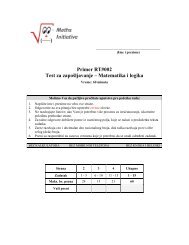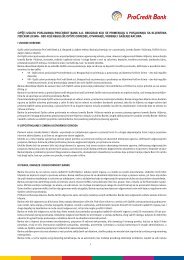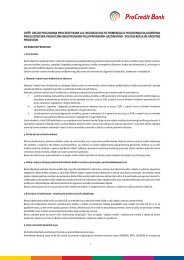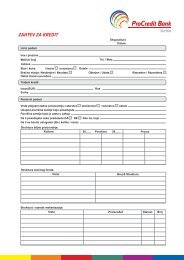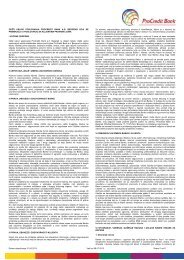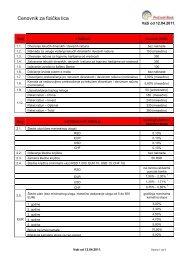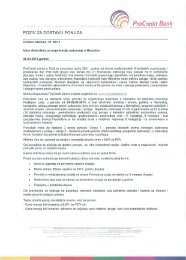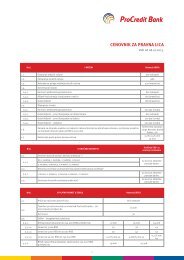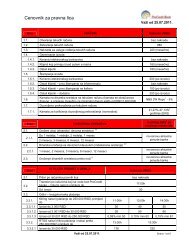Annual Report 2010 - ProCredit Bank
Annual Report 2010 - ProCredit Bank
Annual Report 2010 - ProCredit Bank
- No tags were found...
You also want an ePaper? Increase the reach of your titles
YUMPU automatically turns print PDFs into web optimized ePapers that Google loves.
Financial Statements 55<br />
N) Property and equipment<br />
(b) A group company is the lessor<br />
Premises are stated at historical cost less accumulated depreciation<br />
and provision for impairment, where required. Equipment is<br />
stated at cost, less accumulated depreciation and provision for impairment,<br />
where required.<br />
As at 31 December 2008 the Group performed a revaluation of its<br />
Head Office building in accordance with IAS 16. The valuation was<br />
performed by an independent valuer. The building value was determined<br />
by the valuer using the Comparative Market Price Method.<br />
The Group has recorded in revaluation reserves within Other comprehensive<br />
income the amount of RSD 579,995 thousand, net of<br />
related deferred tax.<br />
In 2009 the Group changed accounting policy and all premises are<br />
stated at historical cost less accumulated depreciation and provision<br />
for impairment, where required (Note 2Y).<br />
Historical cost includes expenditure that is directly attributable to<br />
acquisition of the items.<br />
Subsequent costs are included in the asset’s carrying amount or<br />
are recognized as a separate asset, as appropriate, only when it<br />
is probable that future economic benefits associated with the item<br />
will flow to the Group and the cost of the item can be measured reliably.<br />
All other repairs and maintenance are charged to other operating<br />
expenses during the financial period in which they are incurred.<br />
Depreciation of fixed assets is calculated using the straight-line<br />
method to allocate their cost to their residual values over their estimated<br />
useful lives, as follows:<br />
• Buildings – 40 years,<br />
• Leasehold improvements – shortest of 10 years or leasehold<br />
contract duration,<br />
• Motor vehicles – 5 years,<br />
• Furniture – 10 years,<br />
• Computers – 5 years.<br />
The assets’ residual values and useful lives are reviewed, and adjusted<br />
if appropriate, at each balance sheet date.<br />
Gains and losses on disposals are determined by comparing proceeds<br />
with carrying amount. These are included in other operating<br />
expenses in the income statement.<br />
O) Impairment of non-financial assets<br />
Assets that are subject to amortization and depreciation are reviewed<br />
for impairment whenever events or changes in circumstances<br />
indicate that the carrying amount may not be recoverable. An<br />
impairment loss is recognized for the amount by which the asset’s<br />
carrying amount exceeds its recoverable amount. The recoverable<br />
amount is the higher of an asset’s fair value less costs to sell and<br />
value in use. For the purposes of assessing impairment, assets are<br />
grouped at the lowest levels for which there are separately identifiable<br />
cash flows (cash-generating units).<br />
P) Leases<br />
(a) A group company is the lessee<br />
Leases in which a significant portion of the risks and rewards of ownership<br />
are retained by the lessor are classified as operating leases.<br />
The leases entered into by the Group are primarily operating leases.<br />
The total payments made under operating leases are charged<br />
to other operating expenses in the income statement on a straightline<br />
basis over the period of the lease.<br />
When an operating lease is terminated before the lease period has<br />
expired, any payment required to be made to the lessor by way of<br />
penalty is recognized as an expense in the period in which termination<br />
takes place.<br />
When assets are held subject to a finance lease, the present value<br />
of the lease payments is recognized as a receivable. The difference<br />
between the gross receivable and the present value of the receivable<br />
is recognized as unearned finance income. Lease income is recognized<br />
over the term of the lease using the net investment method<br />
(before tax), which reflects a constant periodic rate of return.<br />
Q) Cash and cash equivalents<br />
For the purposes of the cash flow statement, cash and cash equivalents<br />
comprise balances with less than a three-month maturity<br />
from the date of acquisition, including cash and non-restricted<br />
balances with Central <strong>Bank</strong>, treasury bills and other eligible bills,<br />
loans and advances to banks, amounts due from other banks and<br />
short-term government securities.<br />
R) Provisions<br />
Provisions for legal claims are recognized when: the Group has a<br />
present legal or constructive obligation as a result of past events;<br />
it is more likely than not that an outflow of resources will be required<br />
to settle the obligation; and the amount has been reliably<br />
estimated.<br />
Where there are a number of similar obligations, the likelihood that<br />
an outflow will be required in settlement is determined by considering<br />
the class of obligations as a whole. A provision is recognized<br />
even if the likelihood of an outflow with respect to any item included<br />
in the same class of obligations may be small.<br />
Provisions are measured at the present value of the expenditures<br />
expected to be required to settle the obligation using a pre-tax<br />
rate that reflects current market assessments of the time value of<br />
money and the risks specific to the obligation. The increase in the<br />
provision due to passage of time is recognized as interest expense.<br />
S) Financial guarantee contracts<br />
Financial guarantee contracts are contracts that require the issuer<br />
to make specified payments to reimburse the holder for a loss it incurs<br />
because a specified debtor fails to make payments when due,<br />
in accordance with the terms of a debt instrument. Such financial<br />
guarantees are given to banks, financial institutions and other bodies<br />
on behalf of customers to secure loans, overdrafts and other<br />
banking facilities.<br />
Financial guarantees are initially recognized in the financial statements<br />
at fair value on the date the guarantee was given. Subsequent<br />
to initial recognition, the bank’s liabilities under such guarantees are<br />
measured at the higher of the initial measurement, less amortization<br />
calculated to recognize in the income statement the fee income<br />
earned on a straight line basis over the life of the guarantee and the<br />
best estimate of the expenditure required to settle any financial obligation<br />
arising at the balance sheet date. These estimates are determined<br />
based on experience of similar transactions and history of<br />
past losses, supplemented by the judgment of Management.<br />
Any increase in the liability relating to guarantees is taken to the<br />
income statement under other operating expenses.<br />
T) Employee benefits<br />
(a) Pension obligations<br />
The Group operates a defined contribution pension plan. The Group<br />
companies pay contributions to publicly administered pension<br />
insurance plans on a mandatory basis. The Group has no further<br />
payment obligations once the contributions have been paid. The



